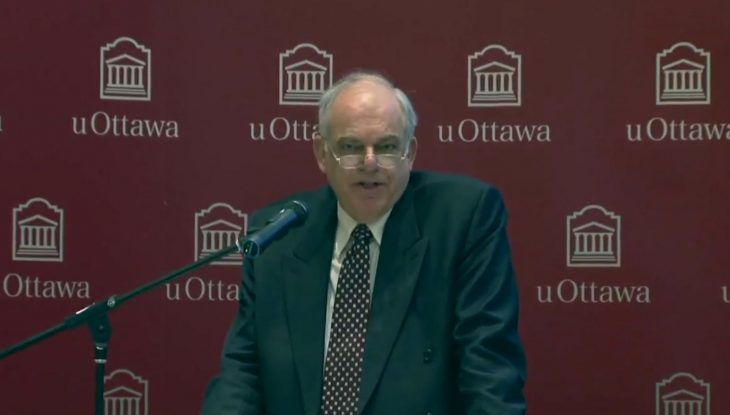
By Konrad von Finckenstein, former CRTC chairman from 2007 to 2012
Section 5.1 and 5.2 were added at the last minute, when Bill C-11 was passed by the House of Commons. There was no discussion or explanation as to why they were needed or how they were intended to function.
They provide:
English and French linguistic minority communities
5.1 In regulating and supervising the Canadian broadcasting system and exercising its powers under this Act, the Commission shall enhance the vitality of official language minority communities in Canada and support and assist their development.
Consultation
5.2 (1) The Commission shall consult with official language minority communities in Canada when making decisions that could adversely affect them.
Objectives of consultations
(2) When engaging in consultations required by subsection (1), the Commission shall
(a) gather information to test its policies, decisions and initiatives;
(b) propose policies, decisions and initiatives that have not been finalized;
(c) seek the communities’ opinions with regard to the policies, decisions or initiatives that are the subject of the consultations;
(d) provide them with all relevant information on which those policies, decisions or initiatives are based;
(e) openly and meaningfully consider those opinions;
(f) be prepared to alter those policies, decisions or initiatives; and
(g) provide the communities with feedback, both during the consultation process and after a decision has been made.
The CRTC is a court of record. Its decisions are based on the principles of due process and transparency. This means it must make decisions on the basis of facts and issues raised before it and shared with everyone. It cannot consider unpresented or unshared facts or opinions.
The CRTC can address issues on its own initiative or on petition from private parties. The authority for dealing with issues stems from the authorizing legislation. Once the issue is raised, the CRTC calls for submissions and holds a hearing, either by way of a viva voce hearing with live submissions or by way of considering written submissions. Any decision arising from a hearing is based on the submissions made to the CRTC. Decisions are published and set out the evaluation of the submissions and the rationale of the CRTC used to reaching its decision.
Decisions of the CRTC are subject to judicial review by the Federal Court and can be set aside if there is a violation of due process.
The question arises: how can the process set out in s. 5.2, which gives special consideration to OMLG’s interests and calls for advance consultations and discussions, be properly integrated into the normal decision-making process of the CRTC.
The salient points of this provision are:
- The CRTC must consult with official minority groups (OLMGs) when making decisions that could affect them adversely
- such consultations must be made before decisions are finalized
- the CRTC must provide OLMGs with the relevant information that pertains to the contemplated decisions
- the CRTC must hold meaningful discussions
- the CRTC must be prepared to alter its proposed policies in light of points made by OLMGs
- the CRTC must give feedback to OLMGs during discussions and after decisions have been reached.
Unfortunately, s. 5.2 does not define what is a decision that could affect adversely OLMGs. Most decisions concerning the Broadcasting Act may have an adverse effect on OMLGs. In addition, one can expect OMLGs to argue in most upcoming issues that decisions to be made could adversely affect them.
In order to ensure that its decisions comply with the legislation, it would be prudent for the CRTC, in all cases touching on language, to adopt the following course of action.
- In any upcoming issue where OLMGs potentially might invoke s. 5.2, the CRTC engages openly in pre-hearing discussions with the OLMGs.
- It shares all available information with the OMLGs.
- It provides preliminary positions to the OLMGs and holds meaningful discussions with them.
- It alters such preliminary positions where required in light of OMLG input.
- It publishes a Consultation Report recounting the issues discussed, the information disclosed to OLMGs, the discissions held and preliminary positions tentatively outlined.
- Once the CRTC proceeds to a regular hearing, the Notice of Hearing that starts the process that will have attached to it the Consultation Report referred to in item 5 above.
- Any OMLG that participated in the consultations has the right to also participate in the regular hearing.
- Once a decision is reached as a result of the regular hearing, the CRTC will publish its decision. It will make specific reference to the pre- hearing consultations held with OMLGs and what influence they had on its decision.
- It will outline in the decision, for OMLGs benefit, the rationale for any alteration made to tentative positions as a result of the regular hearing.
None of this can prevent an OMLG from seeking judicial review alleging s. 5.2 was not properly adhered to.
In addition, parties other than OMLGs may attack the decision arguing that the prehearing process with the OMLGs effectively prejudiced and/or prejudged the outcome of the regular hearing.
While the procedure set out above should provide the CRTC with a relatively sturdy defense it is no guarantee that a decision will not be overturned.
To ensure that the above satisfies all procedural requirements, the CRTC could choose to make a reference to the Federal Court. Such reference would outline the proposed procedure described above and seek a ruling:
- as to whether compliance with the procedure satisfies the requirements of s. 5.2, and
- as to whether such compliance would not prejudice or prejudge the outcome of a regular hearing following the consultations.
Given the sensitivity of language issues and its prevalence in most broadcasting concerns this might be a wise course for the CRTC to follow.



